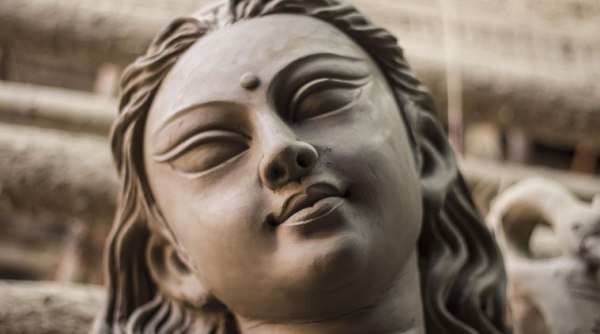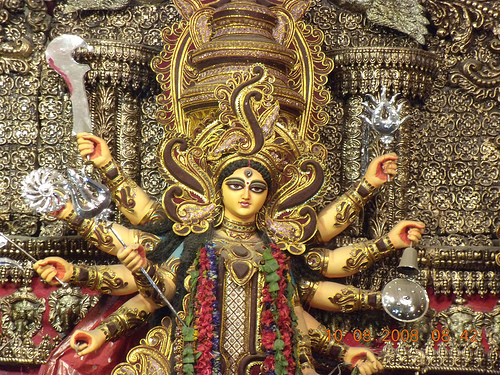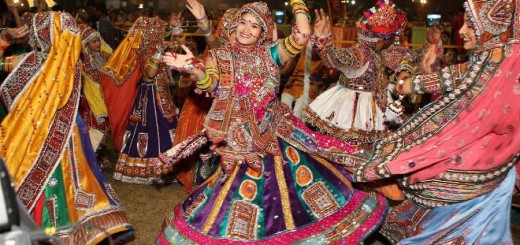Navratri celebrations in Maharashtra
Navratri celebrations in Maharashtra are extremely personal and spiritual. They observe a special ritual called Ghatasthapana on the first day of Navaratri. A small bed of mud is prepared in a container. In the middle of this, an earthen pot filled with water is placed. This vessel symbolizes Goddess Durga. Grains are sown in the soil around the pot and allowed to sprout. Five stems of jowar (a food grain) are also placed over the pot. Women worship this pot for nine days by performing various rituals and offering fruits, flowers, leaves etc. The soil is regularly watered so that the seeds can germinate.

A Durga idol in the making. Life size images of Goddess Durga are installed in all parts of Bengal and Mumbai on the occasion of Navaratri.
In some homes a Kali Puja is performed on the first two days. On the next three days a Lakshmi Puja and on the last four days a Saraswathi Puja are also performed in addition to Ghatasthapana. On the eighth day of the festival (Ashtami), a ‘Yajna’ (a special puja involving fire) is performed to obtain the blessings of Goddess Durga. A Ghat puja is performed on the 9th day. Afterwards, the sprouted plants are pulled from the soil. Some families invite a woman from the Matang community to their home on this day and seek her blessings. She is given food and other items. It is believed that women belonging to the Matang community are the embodiments of Goddess Matangi.
On the 10th day, Dasara or Vijayadashami, men collect the leaves of the tree Apta from the forest or farms. These leaves are called ‘sona’ (gold). Children and often adults visit the homes in the neighborhood and offer these leaves and the saplings removed from the soil to everyone present. They wish each other Happy Dasara and seek the blessings of elders. Vidyarambhan, another ritual performed on Vijayadashami, initiate young children into the world of letters. Actually, this ritual is performed in many parts of South India as well. In fact, Vidyarambam is the most important element of the Navaratri celebrations in Kerala.
Navaratri celebrations in Mumbai, Thane and Navi Mumbai
Mumbai is a great place to see and enjoy the various ways in which Navaratri is celebrated. The city and its satellites (Thane and Navi Mumbai) are home to people from all over India. As a result, Mumbaikars can enjoy every flavor of Navaratri. Garba raas and Dandiya raas dance performances are organized in all parts of Mumbai and Thane on all nine nights of the festival. Most housing societies organize this in their premises. Young men and women performing dandiya on the streets at night is another common sight.

A Durga idol with intricate details. This is an idol installed at a Durga Puja Mandal in Kolkata.
The Bengali community in Mumbai celebrates Durga Puja during the last five days of the festival with great fervor. Life size images of the Goddess are installed in pandals (makeshift shrines) all over the city and worshipped. These idols are then taken out for immersion on the 10th day of the festival (Vijayadashami).
The South Indian community in Mumbai celebrates Navaratri in their own ways. Bomma golus (dolls arranged on steps) are the focal points of their celebrations. Many temples in the city and its suburbs conduct Vidyarambam (initiation into learning) on Vijayadashami.
